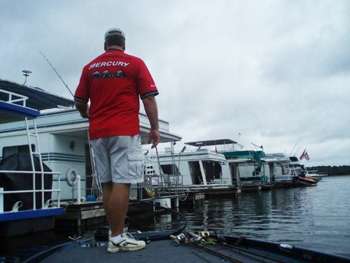
Docks are a lot like women and bass boats. They come in all sizes and shapes, and each has its own personality. And just like with women and bass boats, if you ask three fishermen what they like, you are liable to get three different answers. At least that's what happened to me when I asked a couple of friends about fishing docks.
An Elite perspective
Former Elite Series competitor Preston Clark grew up in Florida, an area loaded with docks, so fishing docks was a big part of his early fishing. Preston says that he looks for docks that have a little deeper water than the others in the area. He especially likes docks on points or docks that have moving water around them.
Clark's two main baits when dock fishing are a shallow running crankbait and a Texas rig worm. "I'll fish fast and cover as much water as possible with the crankbait. Then when I find a dock that has a school of fish, I'll slow down and throw my worm under it."
Jet Skis aren't all bad
Bassmaster Opens pro Daryl Biron, who is from Connecticut, says his favorite time of year to fish docks is postspawn in the spring. He prefers a long, isolated dock on a large, shallow flat with absolutely no cover anywhere near it. Because of the lack of cover, all of the bass in the area will gravitate to that one dock.
Biron's favorite technique for fishing docks is skipping a wacky-rigged Senko. Fishing the Senko wacky style allows the bait to fall slowly and stay in the strike zone longer. Since a large percentage of the bass under the docks during the postspawn will be guarding fry, dropping the Senko through the balls of fry is a very effective way to entice a strike.
"Always look for the areas of the dock that have the Jet Ski ramps" says Biron. These areas will typically have a slight depression under them caused by the wash from loading the Jet Skis. Those slight depressions are key areas for bass to position because of the slightly deeper water in them.
Home sweet homes
I prefer docks that are in dredged channels of housing developments. These docks will have deep water close to shore, uniform depth for most of their length and 6 to 10 feet of water on the ends. Since they are in areas where people have yards, the nutrient levels are generally very high from the fertilizer runoff, and there is often some sort of aquatic vegetation there.
I also look for docks owned by fishermen that will have brush or other cover planted around the dock. These are easy to spot since they will have lights, rod holders and fish feeders on them. On sunny days, I will use slower baits like Texas rigged worms or tubes. When cloud cover moves in, I'll switch to a faster moving bait like a spinnerbait or crankbait.
Three out of three anglers agree
Like I said, three different fishermen, and three entirely different approaches to the same problem. Naturally, regional differences will make the three of us take a slightly different approach to fishing docks, but we have all applied these methods to lakes all over the country and all three approaches work.
There are things that we do all agree on. As Preston Clark said, "10 percent of the docks hold 90 percent of the fish." Finding that 10 percent is the real key to success in dock fishing. You must take all factors into account: time of year, depth of the water around the docks, type of forage in the area and the location of the dock. Once you find the dock that fits your particular style of fishing, you'll have amazing results.
Preston, Daryl and I have all had success with docks, and we all have that memory of the "magic dock" that produced outstanding numbers or quality bass for us. Once you've found your "magic dock," you'll agree with us — not all docks are created equal.




